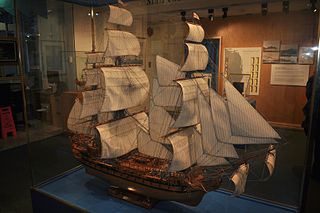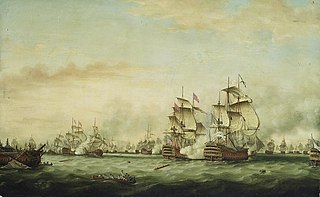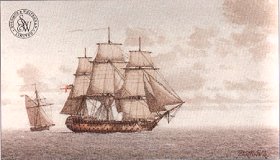
The Battle of Cape St. Vincent was one of the opening battles of the Anglo-Spanish War (1796–1808), as part of the French Revolutionary Wars, where a British fleet under Admiral Sir John Jervis defeated a greatly superior Spanish fleet under Admiral Don José de Córdoba y Ramos near Cape St. Vincent, Portugal.

HMS Orion was a 74-gun third rate ship of the line of the British Royal Navy, launched at Deptford on 1 June 1787 to the design of the Canada class, by William Bately. She took part in all the major actions of the French Revolutionary and Napoleonic Wars under a series of distinguished captains.

HMS Barfleur was a 90-gun second-rate ship of the line of the Royal Navy, designed by Sir Thomas Slade on the lines of the 100-gun ship Royal William, and launched at Chatham Dockyard on 30 July 1768, at a cost of £49,222. In about 1780, she had another eight guns added to her quarterdeck, making her a 98-gun ship; she possessed a crew of approximately 750. Her design class sisters were the Prince George, Princess Royal, and Formidable. She was a ship of long service and many battles.

HMS Captain was a 74-gun third-rate ship of the line of the Royal Navy, launched on 26 November 1787 at Limehouse. She served during the French revolutionary and Napoleonic Wars before being placed in harbour service in 1799. An accident caused her to burn and founder in 1813. Later that year she was raised and broken up.

HMS Edgar was a 74-gun third-rate ship of the line of the Royal Navy, that saw service in the American Revolutionary, French Revolutionary and Napoleonic Wars. Launched in 1779, she fought in the battles of Cape St Vincent and Copenhagen, two of the major naval engagements of the wars.
William Prowse CB was an officer of the Royal Navy, who saw service during the American War of Independence, and the French Revolutionary and Napoleonic Wars. Rising from humble origins and joining the navy as an able seaman, he had a highly active career, serving under some of the most famous naval commanders of the age of sail, and participating in some of their greatest victories. He was at Grenada and Martinique under Byron and Rodney, the Glorious First of June under Howe; and commanded ships at Cape St Vincent under Jervis, Cape Finisterre under Calder and Trafalgar under Nelson. He finished his career by serving with distinction in the Mediterranean, and died with the rank of Rear-Admiral.
Admiral Sir George Mundy, KCB was an officer of the British Royal Navy during the early nineteenth century, serving principally in the French Revolutionary and Napoleonic Wars. Born in Shipley Hall, Derbyshire, the son of politician Edward Miller Mundy, George Mundy joined the Navy at a young age and served in several of the principal actions of the French Revolutionary Wars. He subsequently held a succession of frigate commands during the Napoleonic Wars and was active in the blockade of the French coast and in assisting Spanish irregular forces during the Peninsular War. After the war Mundy remained in service and in 1830 was captain of the royal yacht Royal George. He was knighted in 1837 and continued to rise through the ranks, eventually becoming a full admiral in 1849.

The action of 25 January 1797 was a minor naval battle of the French Revolutionary Wars, fought in the Gulf of Cádiz. The Spanish third-rate ship of the line San Francisco de Asís was attacked and pursued for several hours by a British squadron of three fifth-rates frigates and a sixth-rate corvette under George Stewart, 8th Earl of Galloway. After an intermittent but fierce exchange of fire, the British warships, badly damaged, were eventually forced to withdraw. The San Francisco de Asís, which suffered only minor damage, was able to return to Cádiz without difficulties. The commander of the ship, Captain Alonso de Torres y Guerra, was promoted for his success.

Príncipe de Asturias was a Spanish three-deck 112-gun ship of the line, named after Ferdinand, eldest surviving son of Charles IV of Spain and heir apparent with the title Prince of Asturias. She served during the Napoleonic wars escorting convoys, and fought at different times against both the British and French navies. Her invocation name was Los Santos Reyes.

The action of 26 April 1797 was a minor naval engagement during the French Revolutionary Wars in which a Spanish convoy of two frigates was trapped and defeated off the Spanish town of Conil de la Frontera by British ships of the Cadiz blockade. The British vessels, the ship of the line HMS Irresistible and the Fifth-rate frigate HMS Emerald, were significantly more powerful than the Spanish frigates, which were on the last stage of a voyage carrying treasure from Havana, Cuba, to the Spanish fleet base of Cadiz.
Vice-Admiral Aiskew Paffard Hollis was a Royal Navy officer of the early nineteenth century who is best known for his service in the French Revolutionary and Napoleonic Wars. Born in the 1760s, Hollis entered the Navy in 1774 and served during the American Revolutionary War, seeing action at the Battle of Ushant and the French Revolutionary Wars in which he was badly wounded at the Glorious First of June. In 1801, as the captain of HMS Thames Hollis was heavily engaged at the Second Battle of Algeciras and in the Napoleonic Wars he served in a number of commissions and all major theatres.
Mexicano was a 112-gun three-decker ship of the line built at Havanna for the Spanish Navy in 1786 to plans by Romero Landa. One of the eight very large ships of the line of the Santa Ana class, also known as los Meregildos. Mexicano served in the Spanish Navy for three decades throughout the French Revolutionary and Napoleonic Wars, finally being sold at Ferrol in 1815. Although she was a formidable part of the Spanish battlefleet throughout these conflicts, the only major action Mexicano participated in was the Battle of Cape St Vincent in 1797.
Conde de Regla was a 112-gun three-decker ship of the line built at Havanna for the Spanish Navy in 1786 to plans by Romero Landa. One of the eight very large ships of the line of the Santa Ana class, also known as los Meregildos. Conde de Regla served in the Spanish Navy for three decades throughout the French Revolutionary and Napoleonic Wars. Although she was a formidable part of the Spanish battlefleet throughout these conflicts, the only major action Conde de Regla participated in was the Battle of Cape St. Vincent in 1797.

Real Carlos was a 112-gun three-decker ship of the line built at Havana for the Spanish Navy in 1787 to plans by Romero Landa.

San Hermenegildo was a 112-gun three-decker ship of the line built at Havanna for the Spanish Navy in 1789 to plans by Romero Landa, one of the eight very large ships of the line of the Santa Ana class, also known as los Meregildos. San Hermenegildo served in the Spanish Navy during the French Revolutionary Wars and was destroyed with heavy loss of life during the Second Battle of Algeciras.

Reina Luisa was a 112-gun three-decker ship of the line built at Ferrol for the Spanish Navy in 1791 to plans by José Joaquín Romero Fernández de Landa. One of the eight very large ships of the line of the Santa Ana class, also known as Los Meregildos. The Reina Luisa served in the Spanish Navy for three decades throughout the French Revolutionary and Napoleonic Wars, finally being wrecked off Béjaïa in 1815. Although she was a formidable part of the Spanish battlefleet throughout these conflicts, she did not participate in any major operations.
Captain George Henry Towry was a Royal Navy officer of the late eighteenth and early nineteenth century who is best known for his service as commander of the frigate HMS Dido, in the action of 24 June 1795 in the Western Mediterranean Sea during the French Revolutionary Wars, when, in company with HMS Lowestoffe he successfully fought and defeated the French frigates Minerve and Artémise, capturing Minerve and driving off Artémise. He later commanded HMS Diadem at the Battle of Cape St Vincent in 1797 and served during the Napoleonic Wars on the Transportation Board.
Admiral Sir John Sutton, was a Royal Navy officer of the late eighteenth and early nineteenth century who is best known for his service as captain of the ship of the line HMS Egmont during the French Revolutionary Wars, serving with the Mediterranean Fleet in several prominent engagements. He later served as a judge at the controversial Gambier court-martial in 1809.
Admiral John Child Purvis was a British Royal Navy officer of the late eighteenth and early nineteenth century best known for his service with the British Mediterranean Fleet during the French Revolutionary and Napoleonic Wars. Coming from a naval family, Purvis first saw action in small ships during the American Revolutionary War, later commanding a ship of the line with the Mediterranean Fleet during 1793-1796. During this period he fought in several significant battles against the French. He then served with the Channel Fleet operating at the blockade of Brest and in the Napoleonic Wars was promoted and tasked with maintaining the blockade of Cadiz. After the outbreak of the Peninsular War, Purvis was active in preventing the French capture of Cadiz and at one stage destroyed the city's seaward defences. He retired post-war to his home in Hampshire.











